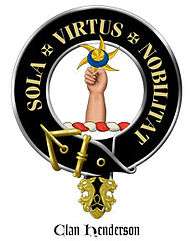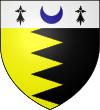Clan Henderson
| Clan Henderson | |
|---|---|
| Mac Eanruig[1] | |
 | |
| Motto |
Sola virtus nobilitat (Virtue alone ennobles)[1] |
| War cry | The Hendersons are here! |
| Profile | |
| Region | Lowlands & Highlands |
| District | Scottish Borders, Glen Coe,[1] & Caithness[1] |
| Plant badge | Cotton grass[1] |
| Chief | |
 | |
| Alistair Henderson of Fordell[1] | |
| Historic seat | Fordell Castle[2] |
The Clan Henderson (Clann Eanruig) is a Scottish clan.[3] The clan's historical seat is at Fordell Castle in Dalgety Bay, Fife. The current clan chief is Alistair Henderson of Fordell.
History
Origins
There are three origins for the Scottish surname of Henderson.[3] The Hendersons who lived in the Scottish Borders seem to be simply the sons of Henry, and here the name is often found in the variant of Henryson.[3] Although these Hendersons were not a significant power in the Borders they were still classed as a riding clan.[3] In about 1374 William Henderson was chamberlain of Lochmaben Castle.[3] He is believed to have died in about 1395.[3]
There were also Hendersons who were septs of the Clan MacDonald of Glencoe and septs of the Clan Gunn in the far north of the country.[3] There is no known connection between the Hendersons of Clan Gunn and Clan MacDonald or the Hendersons of the Scottish Borders.[3]
16th century
In 1513 James Henderson of Fordell was killed along with his eldest son at the Battle of Flodden.[2]
The clan spread from Dumfrieshire to Liddesdale, however they do not appear in the list of border clans that were named by Parliament in 1594, when it was attempting to suppress the Border Reivers.[3] From the Dumfrieshire family of Hendersons descended James Henderson or Henryson who became Lord Advocate in about 1494.[3] He was later appointed to the Bench.[3] He acquired lands in Fordell, Fife and erected a mansion (Fordell Castle).[3] Fordell became the designation of the Lowland Henderson chiefs and it is from them that the present chiefs are descended.[3]
17th century and civil war
One of the most prominent of the Clan Henderson was Alexander Henderson of Fordell who was born in about 1583.[3] He was educated at the University of St Andrews where he became a Master of Arts and a Professor of Philosophy before 1611.[3] He later became the minister of the parish of Leuchars and was violently opposed to Charles I's attempts to reform the Church of Scotland.[3] He was especially opposed to the new prayer book and travelled to Edinburgh where he presented a petition to the Privy Council, stating that the book had not received the sanction of the General Assembly of the Church of Scotland or the Parliament.[3] Henderson and Johnston of Warriston together drafted the National Covenant which was first swon and subscribed in Greyfriars Kirk in Edinburgh.[3] Henderson was unanimously elected moderator of the General Assembly in Glasgow in 1638 and was therefore at the forefront of church politics during the troubled reign of Charles I.[3] Henderson was also responsible for drafting the Solemn League and Covenant in 1643.[3] When the king sundered himself to the Scottish army it was to Henderson that he sent to discuss with his disaffected subjects.[3] Henderson met with the king but failed in his attempts to make him accede to the Church's demands.[3] Henderson died due to ill health in August 1646 and was buried in Greyfriars church yard, the scene of his greatest triumph and where there is a monument to him.[3]
Meanwhile, John Henderson, 5th of Fordell fought as a staunch royalist for the king during the Scottish Civil War.[4][5][6]
Hendersons of Clan MacDonald of Glencoe
There were Hendersons in the far north of the country who lived in Glen Coe, in the Highlands.[3] The English version of their name is taken from the Gaelic Maceanruig, claiming descent from a Pictish prince, Eanruig Mor Mac Righ Neachtain, or big Henry son of King Neachtain. Neachtain (Nechtan mac Der-Ilei) is said to have reigned between 700 and 724.[3] It is not known when the Hendersons came to Glen Coe but it appears that the last of their chiefs in the direct line produced an heiress, who according to tradition had a son by her lover Aonghus Óg of Islay, and that their son was Ian Fraoch.[3] Ian Fraoch's son was Iain Abrach whose patronymic was MacIain and that became the designation of the chiefs of the MacDonalds of Glencoe.[3] The Hendersons were the body guards of the chiefs of the Clan MacDonald of Glencoe.[3] In 1692 when the Massacre of Glencoe took place, the chief's personal attendant and piper, Big Henderson of the Chanters, who was said to be 6 feet, 7 inches tall, was among those killed.[3]
Hendersons of Clan Gunn
Another group of Hendersons lived in Caithness in the far north of the Scottish Highlands and were part of the Clan Gunn.[3] Hendry, one of the younger sons of a chief of the Clan Gunn in the fifteenth century formed his own sept which took the name Henderson.[3]
Chief
The Chief of Clan Henderson is Alistair Donald Henderson of Fordell, an environmental engineer specialising in air pollution control who lives in Melbourne, Australia. The Chief is recognised by Lord Lyon, King of Arms, and is a member of the Standing Council of Scottish Chiefs.
Clan Castles
- Fordell Castle which is about one mile north of Inverkeithing in Fife was once held by the Hendersons, having passed to them from the Airths of Plean in the early sixteenth century.[2] The castle might have been torched in 1568 because the Hendersons supported Mary, Queen of Scots.[2] During the Civil War of the seventeenth century the castle was sacked by the forces of Oliver Cromwell after the Battle of Inverkeithing in 1651.[2] The castle later passed by marriage to the Duncans of Camperdown and the Hendersons moved to a town house on Church Street in Inverkeithing that was known as Fordell's Lodging.[2]
- Otterston Tower is close to Fordell, about two miles west of Aberdour.[2] It is an L-plan tower house although a mansion was later added and remodelled.[2] It was held by the Hendersons in the early sixteenth century and it was they who built the tower, however it had passed to the Mowbrays of Barnbougle by 1589.[2]
- Broomhill House to the south of Edinburgh was held by the Hendersons between 1508 and 1648.[2] However a castle followed by a mansion have since been demolished.[2] The lands later passed to the Bairds of Newbyth and then to the Trotters of Mortonhall.[2]
Septs
Septs and surname variations of the Clan Henderson include:
Gaelic variations:
- MacEanrig / Eanrig
- MacEnrig / Enrig
- MacIanruig / Ianruig
- MacIanrig / Ianrig
- MacInrig / Inrig
- MacCanruig / Canruig
- MacCanrig / Canrig
Anglicised variations:
- (Mac) Anrig / Andrig / An(d)rigson
- (Mac) Enrig / Endrig / Endrigson
- (Mac) Henrig / Hendrig / Hendrigson
- (Mac) Kenrig / Kendrig / Kendrigson
- (Mac) Kanrig / Kandrig / Kandrigson
- (Mac) Canrig / Candrig / Candrigson
- (Mac) Anri(c)k / Andri(c)k / An(d)ri(c)kson
- (Mac) Enri(c)k / Endri(c)k / En(d)ri(c)kson
- (Mac) Henri(c)k / Hendri(c)k / Hen(d)ri(c)kson
- (Mac) Kenri(c)k / Kendri(c)k / Ken(d)ri(c)kson
- (Mac) Kanri(c)k / Kandri(c)k / Kan(d)ri(c)kson
- (Mac) Canri(c)k / CanrCandri(c)k / Can(d)ri(c)kson
- (Mac) Anry / Andry / An(d)ryson
- (Mac) Henry / Hendry / Hen(d)ryson
- (Mac) Kenry / Kendry / Ken(d)ryson
- (Mac) Anrie / Andrie / An(d)rieson
- (Mac) Henrie / Hendrie / Hen(d)rieson
- (Mac) Kenrie / Kendrie / Ken(d)rieson
- (Mac) Anree / Andree / An(d)reeson
- (Mac) Henree / Hendree / Hen(d)reeson
- (Mac) Kenree / Kendree / Ken(d)reeson
- End(h)erson
- Henderson
- Hendron
- Henders
- Hendry
- Henerson
- Descendant - Henderson, Reginald of Old Barns Nova Scotia
among others.
The surname spelling variations arose from regional pronunciation differences, and sometimes perversely creative spelling. Some individuals used multiple surname spellings, and sometimes different surname forms. For example, a traveling Henderson might use the surname MacEanruig in the Scottish Highlands, Henderson in the Lowlands, McHenry in Ulster, and Henry in England.
See also
- Henderson (surname) - for a list of famous Hendersons
- Henderson - places and other things named after Hendersons
- Scottish clan chief
- Scottish clan
- commons:Category:Clan Henderson
Notes and references
- 1 2 3 4 5 6 Clan Henderson Profile scotclans.com. Retrieved 8 April 2014.
- 1 2 3 4 5 6 7 8 9 10 11 12 Coventry, Martin. (2008). Castles of the Clans: The Strongholds and Seats of 750 Scottish Families and Clans. pp. 270. ISBN 978-1-899874-36-1.
- 1 2 3 4 5 6 7 8 9 10 11 12 13 14 15 16 17 18 19 20 21 22 23 24 25 26 27 28 29 30 31 Way, George and Squire, Romily. (1994). Collins Scottish Clan & Family Encyclopedia. (Foreword by The Rt Hon. The Earl of Elgin KT, Convenor, The Standing Council of Scottish Chiefs). pp. 166 - 167.
- ↑ Dalrymple, William. "In Zanzibar". San Francisco: Travel Intelligence. Retrieved 10 April 2012.
Sir John Henderson of Fordel, travelling in his youth through several parts of Asia and Africa from ye year 1618 to ye year 1628, was delivered into slavery by a Barbarian in Zanquebar on the coast of Africa. There a princess of that countrie falling in love with him, even to the renouncing of her religion and country, contrived the means of both their escape and getting aboard a ship trading up ye red sea landed at Alexandria where she died, whose picture John Henderson caused take with her black maid after their own country habit. From ye original picture at Oterston by W Frier, 1731."
- ↑ "English Civil War - Newark besieged". Historia - A collection of coins with their historical context. Retrieved 10 April 2012.
Sir John Digby, the High Sheriff of Nottinghamshire, had seized Newark on behalf of Charles I in late 1642. He was assisted by Sir John Henderson, a Scottish soldier, who it was felt would bring military expertise to the Royalists cause. Henderson was appointed Governor of Newark.
- ↑ Bennett, Martyn (20 July 2008). "Structural - Standing buildings". The English Civil War. Nottingham: Thoroton Society of Nottinghamshire. Retrieved 10 April 2012.
The Governor’s House, Newark: this building was where the governors of the town lived and worked Colonel Sir John Henderson 1642-3, Colonel Sir Richard Byron, 1643-4, Colonel Sir Richard Willys 1644-5 and Colonel John Lord Belasyse, 1645-6.
Further reading
- Hill, Lanette (2006), The Henderson Family History, Lulu.com, pp. 4–5, ISBN 978-1-4357-3675-7 Strong on Hendersons in North America, but self-published so should not be relied on too much.
External links
- The Hendersons, Clan Henderson, or clann Eanruig
- Electric Scotland: Henderson
- Clan Henderson at the Standing Council of Scottish Chiefs
- The Clan Henderson Society